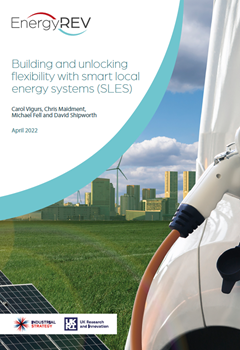Carol Vigurs, Chris Maidment, Michael Fell and David Shipworth
29 April 2022
Transitioning to a low carbon energy system will require a more flexible use of our energy systems to take full advantage of renewables as they are added to the network and to cope with increasing demand such as from electric vehicles. Smart local energy systems can help to provide this flexibility through better coordination and control of generation and storage assets, and by facilitating communication between the networks and actors involved.
This systematic review, supported by interviews with a range of experts and practitioners, identifies “whole system” barriers to unlocking and building flexibility capacity in a UK context; from issues in policy making to attracting investment to individual householders’ attitudes and beliefs. We then present a number of actions that various stakeholders involved in SLES could undertake to address these issues in order to increase flexibility in the energy system and make best use of the flexibility that is available.
These recommendations are arranged by stakeholder in the executive summary for easy referral. The evidence behind the recommendations, the contexts of when, where and how they work, and the ways in which they are interconnected are discussed in more detail in the main report.
